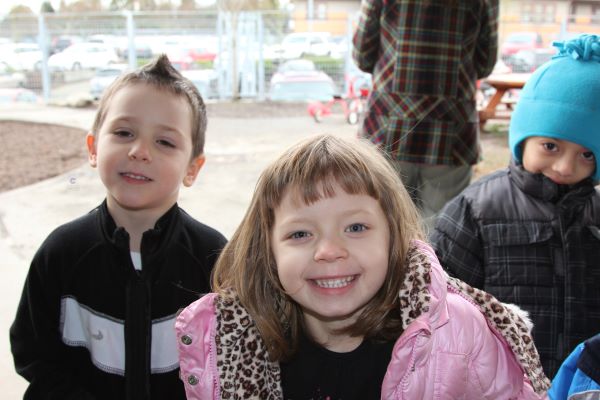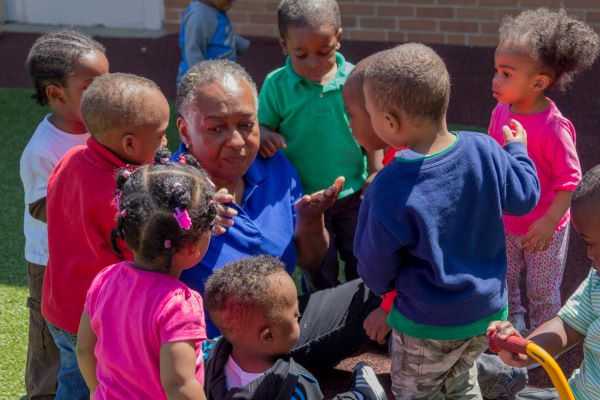Multicultural programming helps children respect and value individual and intersecting cultural differences.
Why It Matters
Every child is unique, and every child belongs. Staff have an opportunity and responsibility to celebrate children’s unique and intersecting identities, while at the same time helping them feel they belong.
- Children make meaning from their early interactions with adults and peers and understand their culture in relation to others.
- Children form their sense of identity and belonging by seeing the ways they are the same and different from others.
- A child’s sense of belonging within a group is tied to an emotional connection or feeling of togetherness. Frequent positive interactions create this connection.
- Talking about differences, grounded in facts and with respect, is a way to decrease biases and racism. Taking a “color-blind” approach, or pretending differences don’t exist, isn’t helpful.
- Staff and families benefit from talking about how to answer questions from children, such as how to explain that a child with disabilities may learn and play differently. If adults don’t help children think about their observations, they will create their ideas about what these differences mean.
Connections to the HSPPS
In this section, learn about example indicators for this Multicultural Principle and how they are supported by the Head Start Program Performance Standards (HSPPS). Think about your program and your learning setting. Then, consider ways you already do these practices and ways you can more closely align to improve your practice.
| Example Indicators | Connections to the HSPPS |
|---|---|
Staff plan activities and interactions that allow children to express what makes them unique. Staff notice and comment when children see differences between people and guide the discussion. Staff share about diverse cultures by reading books. Staff ask questions to help children think critically. | Education and Child Development Services, 45 CFR §1302 Subpart C |
Example Indicators and Practical Strategies
 Review practical strategies drawn from research and Head Start programs that promote a programs capacity to reflect and affirm the cultures of the children and families it serves.
Review practical strategies drawn from research and Head Start programs that promote a programs capacity to reflect and affirm the cultures of the children and families it serves.
Download the Try It! worksheet and choose one practice to focus on for one month. Use the prompts to thoughtfully plan how you will use the practice. The worksheet also includes tips for reflection after using the practice for one month.
Staff plan activities and interactions that allow children to express what makes them unique.
- Greet children and families in a way that respects family preferences.
- Offer chances for children to share information about themselves and their family, culture, and community. For example, they could draw pictures, tell personal stories, or sing a song or do a dance they learned at home or a community event.
- Use children’s observations to show people’s similarities and differences, including their feelings and things they like. Model positive ways to talk about differences (such as “Yes, your hair is ___. Andre’s hair is ___. And my hair is ___.”).
Staff notice when children see differences between people and guide the discussion.
- Notice and comment when infants and young toddlers pay attention to adults and peers who have physical features or use language different from their own. For example, “I see you looking at Daniel’s legs. Daniel has two legs and one foot. He moves differently when he crawls, but he still finds the toys he wants to play with.” or “Are you hearing new sounds? You are noticing that some parents are speaking a different language in our socialization group aren’t you? Adults in your house speak Somali and in our big group you can hear the sounds of English, Vietnamese, and Tagalog all in one room. It’s fun to hear new sounds.”
- Be open to children’s questions and curiosity about the differences they see. It isn’t necessary to have all the answers. It’s most important to be willing to have a conversation.
- Help children understand that everyone takes part in activities and routines, but that sometimes they will be adapted for some children.
- Point out similarities children have in common including preferences for activities, toys, or foods.
- Mix up the groups in small group activities, so children who don’t interact often can work together.
Staff share about diverse cultures by reading books.
- Read books with characters with intersecting identities, including children with disabilities who are dual language learners or bi- or multiracial children, including gender expansive children and children with LGBTQIA2S+ parents and caregivers.
- Choose books that reflect the cultures, languages, and identities of the children to help them develop their identity and sense of belonging. Examples include:
- Board books for infants and toddlers with characters and scenes that show lives like theirs.
- Books for preschoolers that have characters who speak different languages and show diverse ways of doing daily activities (such as cooking and celebrating).
- Books written and illustrated by the children, to share parts of their lives.
Staff ask questions to help children think critically.
 While reading a storybook, staff may ask children questions to help them think about their own experiences and those of others. Adults can ask infants and young toddlers open-ended questions. They may answer these questions for the child, but the child has the opportunity to hear these questions and as they get older and begin to acquire language, they can answer for themselves. Questions like this teach children to connect to their own experiences and those of others.
While reading a storybook, staff may ask children questions to help them think about their own experiences and those of others. Adults can ask infants and young toddlers open-ended questions. They may answer these questions for the child, but the child has the opportunity to hear these questions and as they get older and begin to acquire language, they can answer for themselves. Questions like this teach children to connect to their own experiences and those of others.
- Who is this story about?
- What do you know about this person?
- Does this person remind you of someone you know?
- Does your family share a similar story?
Voices from the Head Start Community
In this section, Head Start educators share their experiences engaging with children to learn about different cultures together.
Cultural representation matters.
A Head Start classroom teacher shared that in all her years of teaching, she had not thought much about her heritage or her family’s culture. One day she was reading a story to the children about an Italian grandmother who joyfully prepared dinner for her family. It was a moment of connection for her. The story brought her “home.” She suddenly felt the pride she had for her family and her Italian heritage. She said that before that moment, she did not understand how powerful multicultural programming could be for children.
A week later, she chose a storybook about an American Indian child, because there was one child of Kiowa heritage in her class. At that time, there was little representation of the child’s culture in the curriculum. She said that the child immediately came up after she read the story. They looked at the pictures in the book and revisited the pages that interested the child. The teacher sent the book home with her and encouraged her to share it with her family. This simple gesture created a stronger relationship between the Head Start center and the family. During the next month, her mother came to the classroom as a volunteer, and both parents came together to the parent meeting the following month.
Be inclusive of various family structures.
Staff at a Head Start program noticed that several of their families were made up of grandparents raising grandchildren. An educator from the program shared:
“Showing kids that we're all made up of different components, and we all have people in our lives. Sometimes our families are made up the same way, sometimes they're not. One of the things that we've noticed here recently with our enrollment is we have a lot of families who are made up of grandparents raising grandchildren. So yes, we've had the opportunity to open our classrooms for, you know, those grandparents to come in too. And the kids love it, because then one child’s grandparent becomes all 17 children’s grandparent, and they're asking, you know, when is Grandpa coming again? So, it's so fun to have those opportunities, but for the parents to know and the families to know that this is a safe place for you.”
Explain how to learn from our mistakes.
Staff at Head Start program talked about meeting the needs of families who come from different cultural or linguistic backgrounds. Even though staff are committed to equitable, anti-bias practices, they may still unintentionally make mistakes. They talk about this with children. They call it an “oops” moment and say it’s part of the learning process. While “oops” moments are not intentional, children and adults need to learn from them and find ways not to repeat the same mistakes.
Reflect
Early childhood programs can use the following questions as a starting point — to take a look at the challenges they face and the approaches they might use to promote culturally sustaining and equitable practice across service delivery areas. The questions listed below are designed for self-reflection and critical assessment of practice and can also be used with groups of staff, with families, and with community partners to spark dialogue. In order to go deeper into some topics in a group setting, programs may benefit from session leaders who are skilled facilitators either among their staff or from outside their program.
- How do you engage with family members who have cultural views on caregiving and teaching that are different from yours? Share examples from your own experience, and strategies you used to deal with tension.
- If your program serves infants and toddlers: How does your program gather information about the caregiving practices of families? For example, how do you understand how a family feeds their child, puts their child to sleep, or holds their child?
- How do your learning environments reflect the cultures of the children enrolled? How do daily learning experiences allow children to learn about and develop respect for other cultures?
- What opportunities do families have to form relationships with other families and to develop new understandings of individuals from different cultural groups in the community?
Deepen Your Learning
Explore these useful resources to learn more about ways to help children understand and respect cultural differences.
- How to Use Bilingual Books
- Healthy Gender Development: A Guide for Early Childhood Programs and Professionals
- Partnerships That Foster Development and Learning
- Talking to Children About Differences and Similarities
- Talking to Young Children About Race
Read more:
Resource Type: Article
National Centers: Early Childhood Development, Teaching and Learning
Audience: Directors and Managers
Last Updated: June 25, 2024